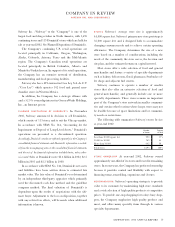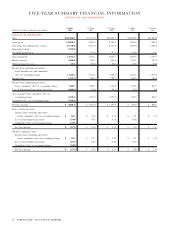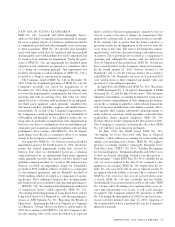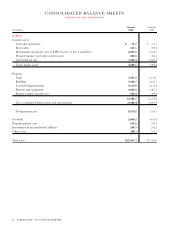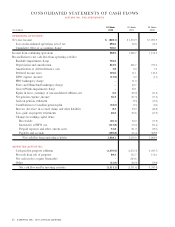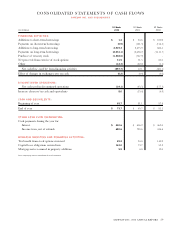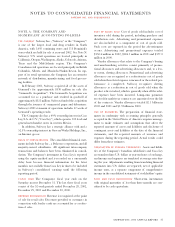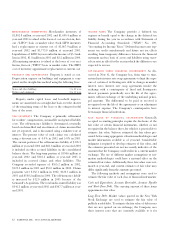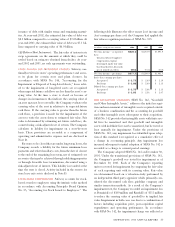Safeway 2002 Annual Report Download - page 25
Download and view the complete annual report
Please find page 25 of the 2002 Safeway annual report below. You can navigate through the pages in the report by either clicking on the pages listed below, or by using the keyword search tool below to find specific information within the annual report.
SAFEWAY INC. 2002 ANNUAL REPORT 23
NEW ACCOUNTING STANDARDS
SFAS No. 142, “Goodwill and Other Intangible Assets,”
addresses the initial recognition and measurement of intangi-
ble assets acquired outside of a business combination and the
accounting for goodwill and other intangible assets subsequent
to their acquisition. SFAS No. 142 provides that intangible
assets with finite useful lives be amortized and that goodwill
and intangible assets with indefinite lives not be amortized, but
be tested at least annually for impairment. Under the provi-
sions of SFAS No. 142, any impairment loss identified upon
adoption of this standard is recognized as a cumulative effect
of a change in accounting principle. Any impairment loss
incurred subsequent to initial adoption of SFAS No. 142 is
recorded as a charge to current period earnings.
The Company adopted SFAS No. 142 on December 30,
2001. Under the transitional provisions of SFAS No. 142, the
Company’s goodwill was tested for impairment as of
December 30, 2001. Each of the Company’s reporting units
was tested for impairment by comparing the fair value of each
reporting unit with its carrying value. Fair value was deter-
mined based on a valuation study performed by an independ-
ent third party appraiser which primarily considered the
discounted cash flow, guideline company and similar transac-
tion methods. As a result of the Company’s impairment test,
the Company recorded an impairment loss for Dominick’s of
$589 million and Randall’s of $111 million to reduce the car-
rying value of goodwill to its implied fair value. Impairment in
both cases was due to a combination of factors including acqui-
sition price, post-acquisition capital expenditures and operating
performance. In accordance with SFAS No. 142, the impair-
ment charge was reflected as a cumulative effect of accounting
change in the Company’s statement of operations.
As required by SFAS No. 142, Safeway tested goodwill for
impairment again in the fourth quarter of 2002, which rep-
resents the annual impairment testing date selected by
Safeway. Fair value was determined based on a valuation
study performed by an independent third party appraiser
which primarily used the discounted cash flow method and
guideline company method. As a result of this annual review,
Safeway recorded an impairment charge for Dominick’s
goodwill of $583.8 million, which is recorded as a component
of discontinued operations, and for Randall’s goodwill of
$704.2 million, which is recorded as a component of operat-
ing income. These additional charges reflect declining multi-
ples in the retail grocery industry and operating performance.
SFAS No. 144, “Accounting for the Impairment or Disposal
of Long-Lived Assets,” which supersedes SFAS No. 121,
“Accounting for the Impairment of Long-Lived Assets and for
Long-Lived Assets to be Disposed of,” and the reporting pro-
visions of APB Opinion No. 30, “Reporting the Results of
Operations – Reporting the Effects of Disposal of a Segment
of a Business,” became effective for Safeway on December 30,
2001. In accordance with SFAS No. 144, the Company evalu-
ates the carrying value of the assets in relation to its expected
future cash flows whenever management commits to close or
relocate a store or because of changes in circumstances that
indicate the carrying value of an asset may not be recoverable.
If the carrying value is greater than the future cash flows, a
provision is made for the impairment of the assets to write the
assets down to fair value. Fair value is determined by estimat-
ing net future cash flows, discounted using a risk-adjusted rate
of interest. These provisions are recorded as a component of
operating and administrative expense and are disclosed in
Note D. Adoption of this provision of SFAS No. 144 did not
have a material effect on the Company’s financial statements.
In the fourth quarter of 2002, Safeway decided to sell
Dominick’s and to exit the Chicago market. In accordance
with SFAS No. 144, Dominick’s net assets as of year-end 2002
were written down to their estimated fair market value and
presented as a discontinued operation.
In April 2002, the FASB issued SFAS No. 145, “Rescission
of FASB Statements No. 4, 44 and 64, Amendment of FASB
Statement No. 13, and Technical Corrections.” This statement
eliminates extraordinary accounting treatment for a gain or loss
reported on the extinguishment of debt, eliminates inconsisten-
cies in the accounting required for sale-leaseback transactions
and certain lease modifications with similar economic effects,
and amends other existing authoritative pronouncements to
make technical corrections, clarify meanings or describe their
applicability under changed conditions. SFAS No. 145
becomes effective for the Company in the first quarter of 2003.
The Company is currently analyzing the effect that SFAS
No. 145 will have on its financial statements.
In June 2002, the FASB issued SFAS No. 146,
“Accounting for Costs Associated with Exit or Disposal
Activities,” which addresses accounting for restructuring and
similar costs, including store closures. SFAS No. 146 replaces
previous accounting guidance, principally Emerging Issues
Task Force Issue (“EITF”) No. 94-3, “Liability Recognition
for Certain Employee Termination Benefits and Other Costs
to Exit an Activity (including Certain Costs Incurred in a
Restructuring).” Under EITF Issue No. 94-3, a liability for an
exit cost was recognized at the date of the company’s com-
mitment to an exit plan. SFAS No. 146 requires that the lia-
bility for costs associated with an exit or disposal activity be
recognized when the liability is incurred. In accordance with
SFAS No. 146, store lease exit costs are accrued when a store
is closed. SFAS No. 146 also establishes that the liability
should initially be measured and recorded at fair value. SFAS
No. 146 may affect the timing of recognizing future store clo-
sures and restructuring costs, if any, as well as the amounts
recognized. The Company adopted the provisions of SFAS
No. 146 during the third quarter of 2002 for any leased store-
closure activities initiated after June 15, 2002. Adoption of
this standard did not have a material effect on the Company’s
financial statements.
No. 145 will have on its financial statements.


